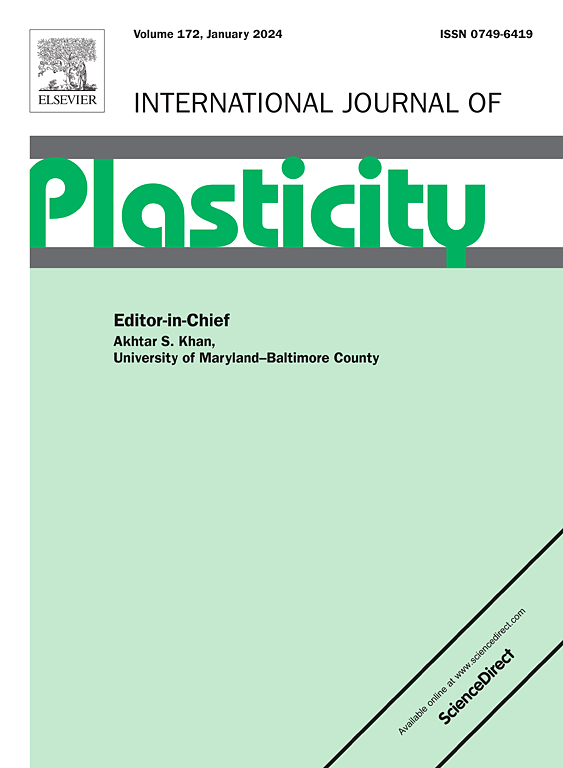用非均匀位错-密度三维元胞自动机量化低合金钢在不同变形条件下的多阶段再结晶
IF 9.4
1区 材料科学
Q1 ENGINEERING, MECHANICAL
引用次数: 0
摘要
在热成形过程中,合金在不同的温度和应变速率下经历严重的塑性变形,使动态再结晶(DRX)行为复杂化。目前在恒定变形条件下建立的DRX模型在预测复杂应力和微观结构演变方面精度有限。本文建立了一个三维元胞自动机(CA)模型来精确预测低合金钢在不同变形条件下的DRX显微组织和流变应力。该模型结合位错密度梯度和晶界滑动来量化热压缩过程中基体和多阶段再结晶晶粒中的位错密度演变。基于一种新的现象本构模型,推导了位错积累和湮灭相关的参数变量,其中考虑了50% DRX分数的时间变化和第一阶段再结晶引起的残余软化。CA模拟结果表明,瞬态增大Zener-Hollomon参数ZPZP后出现峰值应力后的应力软化是由于位错差异导致基体和第一阶段DRX晶粒(DRXGsI)细化所致。由于第二阶段DRX晶粒(DRXGsII)的形核延迟,DRXGsI不能完全细化,导致最终晶粒尺寸较大。降低ZPZP后,即使DRX分数增加到一定条件下的水平,由于位错-密度分布不均匀,一些基体仍然表现出较高的位错密度。这将DRXGsI的生长速度加快到与恒定条件下相似的大小,从而产生与实验结果密切匹配的应力降低速率。所提出的模拟框架不仅有助于可视化多阶段再结晶过程,而且有助于热锻过程中微观组织的定量控制。本文章由计算机程序翻译,如有差异,请以英文原文为准。


Quantification of multi-stage recrystallization in low-alloy steel under varying deformation conditions using inhomogeneous-dislocation-density 3D cellular automaton
In the thermoforming process, alloys experience severe plastic deformation under varying temperatures and strain rates, complicating dynamic recrystallization (DRX) behavior. Current DRX models developed under constant deformation conditions have limited accuracy in predicting complex stress and microstructure evolutions. This work develops a 3D cellular automaton (CA) model to precisely predict the DRX microstructure and flow stress of low-alloy steel under varying deformation conditions. The model incorporates dislocation density gradients and grain-boundary sliding to quantify dislocation density evolutions in matrix and multi-stage recrystallization grains during hot compression. Parameter variables related to dislocation accumulation and annihilation are derived from a new phenomenological constitutive model, in which the variation of the time for 50 % DRX fraction and the residual softening induced by the first-stage recrystallization are considered. CA simulation results illustrate that the stress softening following peak stress after transiently increasing the Zener-Hollomon parameter is attributed to the refinement of matrix and first-stage DRX grains (DRXGsI) resulting from dislocation differences. DRXGsI cannot be fully refined due to delayed nucleation of second-stage DRX grains (DRXGsII), resulting in a greater final grain size. After decreasing , even if the DRX fraction increases to levels under constant conditions, some matrix still exhibits higher dislocation density due to an inhomogeneous-dislocation-density distribution. This accelerates DRXGsI growth to a size similar to that under the constant condition, producing a stress-decreasing rate that closely matches experimental findings. The proposed simulation framework not only contributes to visualizing multi-stage recrystallization but also aids in quantitative microstructure control during hot forging.
求助全文
通过发布文献求助,成功后即可免费获取论文全文。
去求助
来源期刊

International Journal of Plasticity
工程技术-材料科学:综合
CiteScore
15.30
自引率
26.50%
发文量
256
审稿时长
46 days
期刊介绍:
International Journal of Plasticity aims to present original research encompassing all facets of plastic deformation, damage, and fracture behavior in both isotropic and anisotropic solids. This includes exploring the thermodynamics of plasticity and fracture, continuum theory, and macroscopic as well as microscopic phenomena.
Topics of interest span the plastic behavior of single crystals and polycrystalline metals, ceramics, rocks, soils, composites, nanocrystalline and microelectronics materials, shape memory alloys, ferroelectric ceramics, thin films, and polymers. Additionally, the journal covers plasticity aspects of failure and fracture mechanics. Contributions involving significant experimental, numerical, or theoretical advancements that enhance the understanding of the plastic behavior of solids are particularly valued. Papers addressing the modeling of finite nonlinear elastic deformation, bearing similarities to the modeling of plastic deformation, are also welcomed.
 求助内容:
求助内容: 应助结果提醒方式:
应助结果提醒方式:


